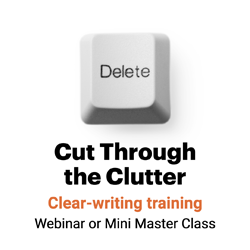Use it as a headline, deck or nut graph
Once you’ve found your focus and written your one-sentence story summary, use it.

A well-written summary statement can become a headline, deck or theme sentence. That summary communicates your idea clearly to your reader while it keeps you on track.
Here’s how some writers and editors have used summary sentences to make their points:
- What to buy when you have enough to give the very best: the theme sentence for Ingram’s magazine guide to luxury gift giving
- How to manage your newfound nest egg: the theme sentence for a mutual fund company’s marketing magazine article on how baby boomers should handle an inheritance
- Build new networks, reach real people, master social media: the theme sentence for PRSA’s 2009 Digital Impact Conference
“When you have that ‘one thing’ … that free offer, 20% discount or whatever … get it into your headline,” writes Nick Usborne, author of NetWords.
Use it … or your readers might lose it.
Test for focus.
Finally, make sure every paragraph — indeed, every sentence, every phrase, every word — in your piece works together to support your theme. To test this, reread your copy with your focus in mind.
With each paragraph, don’t just ask, “Does this paragraph work?” Also ask, “Does this paragraph work to further my focus?”
You define your focus more by what you leave out than by what you put into your story. So if a phrase or sentence doesn’t pass the test, take it out.
That’s focus.

Leave a Reply